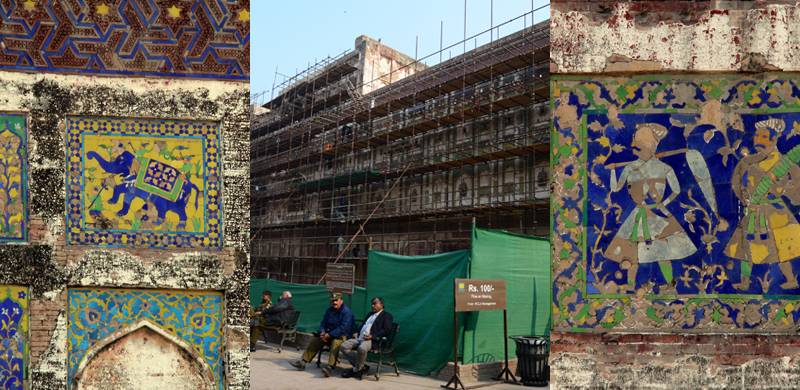
Let me take you to a marvel inside the walled city of Lahore - the grand wall of Lahore fort - and stands there as the most ornamental and world’s largest Picture Wall. The Lahore Fort’s Picture Wall is one of the principal features of the UNESCO World Heritage Site. It is about 440 meters (1,450 feet) long, with an average height of 16 meters (50 feet) and forms the northern and western facade of the Lahore Fort. Parts of the facades are extensively embellished in cut brickwork, cut glazed tile mosaic work, filigree work, and painted lime plaster. The wall consists of an array of recessed panels, which are exquisitely decorated with imagery of hunting, battle scenes, angels and demons, human figures, animals, birds, as well as geometric and floral patterns. Furthermore, the eaves and brackets of pavilions and other rooftop structures are carved in sandstone and marble-work inlaid with semi-precious stones.
Built by Mughal Emperor Akbar over 400 years ago, and later enlarged by Emperor Jahangir and Shah Jahan, the wall represents the artistic impressions and characteristics of three Mughal rulers. Here let me mention this too that Lahore fort is the only place in the subcontinent which has seen the rules of four Mughal Emperors, Akbar, Jahangir, Shah Jahan and Aurangzeb.
https://www.youtube.com/watch?v=WhYHQUghcmc
The sequence of developments during the different reigns is visible in the progressive variations in the iconography of the Picture Wall's tile decorations. The tile decorations that belong to the late Akbari period consist largely of floral motifs. These change to include imagery of human and animal figures during Jahangir's rule. During the reign of Shah Jahan, the scale and images of the Picture Wall became obviously enhanced and colourful both in narrative and decorative style. Through embellished brickwork, glazed tile mosaics, filigree work and frescoes, the imagery reveals aspects related to the life and entertainment in the royal courts, and consists of descriptions of battles, animal fights, fairies, angels and demons.
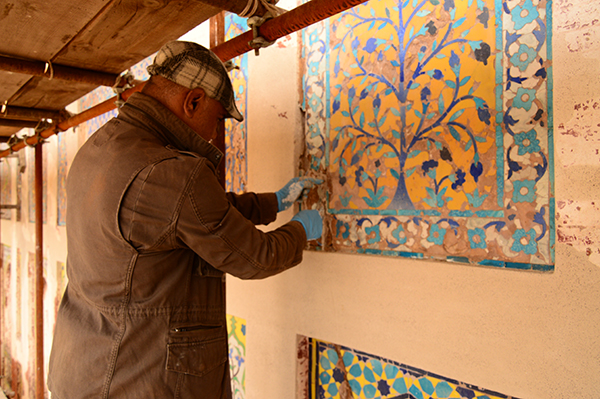
The Picture Wall's tile-work and decorative scheme cannot be studied in isolation from its adjacent structures. The northern part of the wall's west facade forms part of the Shah Burj, which includes the Summer Palace and the Sheesh Mahal Quadrangle. The five arches on the second level of the Picture Wall form the main facade of the Summer Palace which was Shah Jahan's private quarters and is the basement of Sheesh Mahal.
In 1799, Ranjit Singh took over Lahore and used the Sheesh Mahal as his private quarters. He built a double-storey structure on top of the existing fabric, causing extensive damage to the Picture Wall, which was not designed to withstand the additional weight. The Sikh accession wars in 1841 further damaged the wall and to this day, bullet holes can be identified on the tile mosaics.
https://www.youtube.com/watch?v=XNrkejM2rMk&t=1s
During the British rule the Fort was used as a military compound with tennis courts set up in Jahangir's Quadrangle and building barracks against the lowest level of the west facade of the Picture Wall. This caused major damage to the wall that was never repaired. Furthermore, the arched windows of the Summer Palace, that form part of the west facade of the wall, were plastered up to allow using it as a storeroom.
The Picture Wall has been mentioned in many accounts of Western visitors to the subcontinent. However, it was most comprehensively documented in 1920 by Dutch historian, J. Ph. Vogel, who not only wrote about the history of the wall, but also documented it in the form of plans, elevations, and lithographs of 116 pictorial panels.
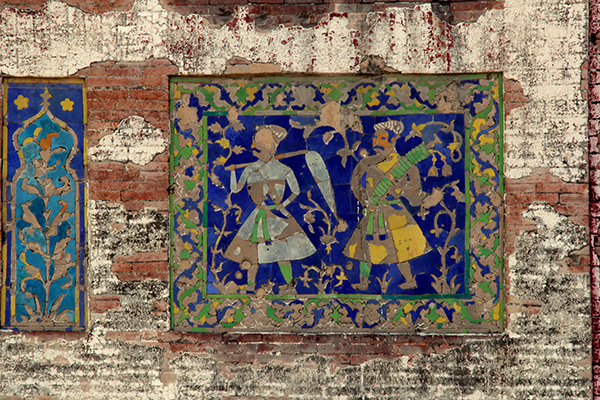
With the passage of time this huge ornamented wall became a neglected part of the fort and people or tourists were unable to understand its importance. The external factors like a road that was running close to it, aging, and water ingress also damaged the wall.
There were waist high shrubs around the wall and the northern part was not accessible at all because of the debris, storerooms and wild plants growth over there. No one had realised the importance of this wall and it was not given the attention it demanded in actual.
https://www.youtube.com/watch?v=-LptZXb2TZc&t=8s
Somehow in 2015 the Aga Khan Cultural Service-Pakistan (under a partnership agreement with the Walled City of Lahore Authority (WCLA) started the documentation of the Picture Wall as part of a larger 'Conservation of the Lahore Fort' project.
The project to conserve the Picture Wall began with a period of extensive documentation, generously supported by the Royal Norwegian Embassy, which involved using a 3-D laser scanner and Electronic Distance Measurement (EDM) devices, as well as high-resolution ortho-rectified photography that was then superimposed onto accurate drawings of the structure.
This provided a detailed visual record of the as-found condition of the wall, and laid the groundwork for the analysis and planning phase of the project. Thematic drawings demonstrating former interventions, different decoration techniques, and the condition of ornamented surfaces were produced. Additionally, scholarly research pertaining to original manufacturing techniques and the iconography of tile mosaics was carried out.
After the completion of detailed documentation, a technical review of the challenges pertaining to the conservation of various decorative elements led to the selection of a 10-meter wide and 15-meter high section of the western facade of the wall for prototype conservation, which was to inform the Picture Wall's conservation principles and methodologies.
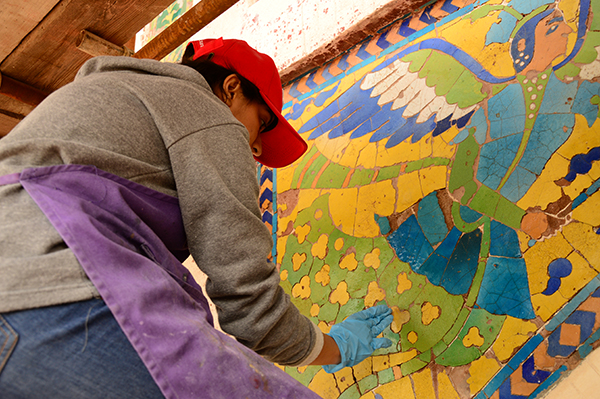
This process followed by an International Workshop at the Lahore Fort in January 2018 with an objective was to review and assess the 'prototype' conservation to arrive at a final course of action for the conservation of the Picture Wall's western facade, which consists of 635 decorated recessed panels composed on three levels.
In Pakistan, the conservation of frescoes and other architectural surfaces traditionally involves the replacement and reconstruction of decayed sections. However, contrary to this approach, the goal of the conservation of the Picture Wall's western facade was not to reconstruct missing pieces, but instead to protect and enhance what remains of it.
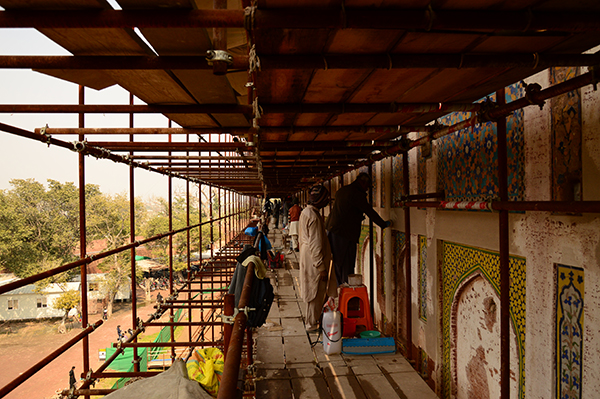
For this reason, reconstruction was kept at a minimum and only implemented where there was a clear aesthetic benefit, and where the original decoration of the wall was completely lost. In such sections, paint was used to reconstruct the coloured glaze. Additionally, pieces of glazes, without a ceramic body, were also used to reconstruct missing sections of the tiled murals.
The project warranted the expertise of both heritage crafts as well as conservators. Trained craftsmen dealt with areas where partial reconstruction was required and conservators were entrusted with the responsibility of stabilisation, cleaning, and the final presentation of the original surfaces.
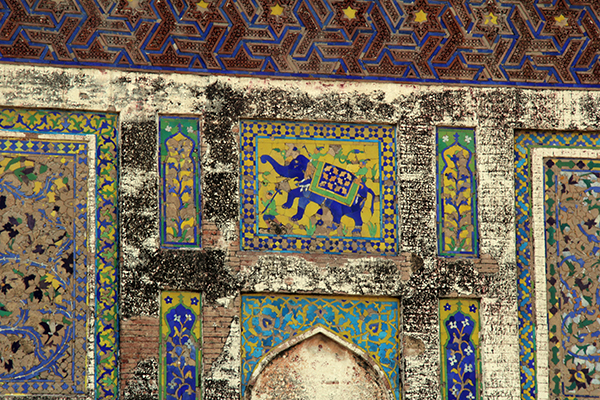
It is great to see now that the western facade of the Picture Wall has been completely conserved and will be opened for the public by the end of March 2019. This is surely a milestone in the history of Lahore fort as the most unique wall and largest in world is being conserved using the international standards of conservation.
The conservation of the Picture Wall's northern facade is expected to begin in April 2019, and be completed in 2021. While the conservation principles and methodologies developed for the western facade of the Picture Wall will inform the course of action for the conservation of the wall's northern facade, the latter presents its own set of unique challenges, which will have to be studied and dealt with accordingly.
Built by Mughal Emperor Akbar over 400 years ago, and later enlarged by Emperor Jahangir and Shah Jahan, the wall represents the artistic impressions and characteristics of three Mughal rulers. Here let me mention this too that Lahore fort is the only place in the subcontinent which has seen the rules of four Mughal Emperors, Akbar, Jahangir, Shah Jahan and Aurangzeb.
https://www.youtube.com/watch?v=WhYHQUghcmc
The sequence of developments during the different reigns is visible in the progressive variations in the iconography of the Picture Wall's tile decorations. The tile decorations that belong to the late Akbari period consist largely of floral motifs. These change to include imagery of human and animal figures during Jahangir's rule. During the reign of Shah Jahan, the scale and images of the Picture Wall became obviously enhanced and colourful both in narrative and decorative style. Through embellished brickwork, glazed tile mosaics, filigree work and frescoes, the imagery reveals aspects related to the life and entertainment in the royal courts, and consists of descriptions of battles, animal fights, fairies, angels and demons.

The Picture Wall's tile-work and decorative scheme cannot be studied in isolation from its adjacent structures. The northern part of the wall's west facade forms part of the Shah Burj, which includes the Summer Palace and the Sheesh Mahal Quadrangle. The five arches on the second level of the Picture Wall form the main facade of the Summer Palace which was Shah Jahan's private quarters and is the basement of Sheesh Mahal.
In 1799, Ranjit Singh took over Lahore and used the Sheesh Mahal as his private quarters. He built a double-storey structure on top of the existing fabric, causing extensive damage to the Picture Wall, which was not designed to withstand the additional weight. The Sikh accession wars in 1841 further damaged the wall and to this day, bullet holes can be identified on the tile mosaics.
https://www.youtube.com/watch?v=XNrkejM2rMk&t=1s
During the British rule the Fort was used as a military compound with tennis courts set up in Jahangir's Quadrangle and building barracks against the lowest level of the west facade of the Picture Wall. This caused major damage to the wall that was never repaired. Furthermore, the arched windows of the Summer Palace, that form part of the west facade of the wall, were plastered up to allow using it as a storeroom.
The Picture Wall has been mentioned in many accounts of Western visitors to the subcontinent. However, it was most comprehensively documented in 1920 by Dutch historian, J. Ph. Vogel, who not only wrote about the history of the wall, but also documented it in the form of plans, elevations, and lithographs of 116 pictorial panels.

With the passage of time this huge ornamented wall became a neglected part of the fort and people or tourists were unable to understand its importance. The external factors like a road that was running close to it, aging, and water ingress also damaged the wall.
There were waist high shrubs around the wall and the northern part was not accessible at all because of the debris, storerooms and wild plants growth over there. No one had realised the importance of this wall and it was not given the attention it demanded in actual.
https://www.youtube.com/watch?v=-LptZXb2TZc&t=8s
Somehow in 2015 the Aga Khan Cultural Service-Pakistan (under a partnership agreement with the Walled City of Lahore Authority (WCLA) started the documentation of the Picture Wall as part of a larger 'Conservation of the Lahore Fort' project.
The project to conserve the Picture Wall began with a period of extensive documentation, generously supported by the Royal Norwegian Embassy, which involved using a 3-D laser scanner and Electronic Distance Measurement (EDM) devices, as well as high-resolution ortho-rectified photography that was then superimposed onto accurate drawings of the structure.
This provided a detailed visual record of the as-found condition of the wall, and laid the groundwork for the analysis and planning phase of the project. Thematic drawings demonstrating former interventions, different decoration techniques, and the condition of ornamented surfaces were produced. Additionally, scholarly research pertaining to original manufacturing techniques and the iconography of tile mosaics was carried out.
After the completion of detailed documentation, a technical review of the challenges pertaining to the conservation of various decorative elements led to the selection of a 10-meter wide and 15-meter high section of the western facade of the wall for prototype conservation, which was to inform the Picture Wall's conservation principles and methodologies.

This process followed by an International Workshop at the Lahore Fort in January 2018 with an objective was to review and assess the 'prototype' conservation to arrive at a final course of action for the conservation of the Picture Wall's western facade, which consists of 635 decorated recessed panels composed on three levels.
In Pakistan, the conservation of frescoes and other architectural surfaces traditionally involves the replacement and reconstruction of decayed sections. However, contrary to this approach, the goal of the conservation of the Picture Wall's western facade was not to reconstruct missing pieces, but instead to protect and enhance what remains of it.

For this reason, reconstruction was kept at a minimum and only implemented where there was a clear aesthetic benefit, and where the original decoration of the wall was completely lost. In such sections, paint was used to reconstruct the coloured glaze. Additionally, pieces of glazes, without a ceramic body, were also used to reconstruct missing sections of the tiled murals.
The project warranted the expertise of both heritage crafts as well as conservators. Trained craftsmen dealt with areas where partial reconstruction was required and conservators were entrusted with the responsibility of stabilisation, cleaning, and the final presentation of the original surfaces.

It is great to see now that the western facade of the Picture Wall has been completely conserved and will be opened for the public by the end of March 2019. This is surely a milestone in the history of Lahore fort as the most unique wall and largest in world is being conserved using the international standards of conservation.
The conservation of the Picture Wall's northern facade is expected to begin in April 2019, and be completed in 2021. While the conservation principles and methodologies developed for the western facade of the Picture Wall will inform the course of action for the conservation of the wall's northern facade, the latter presents its own set of unique challenges, which will have to be studied and dealt with accordingly.
